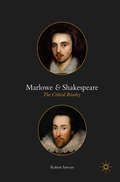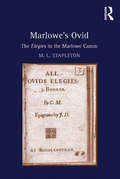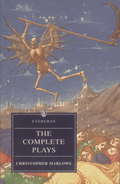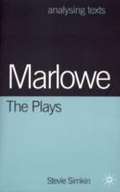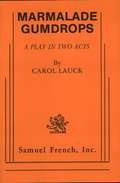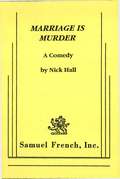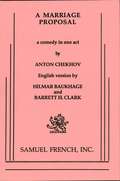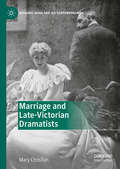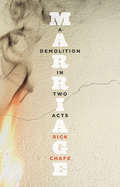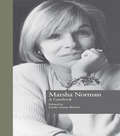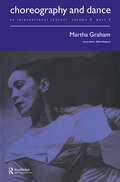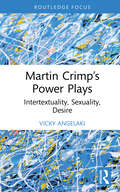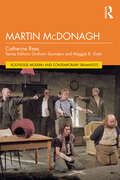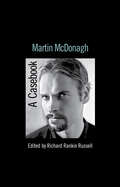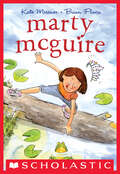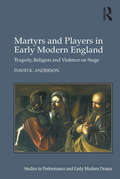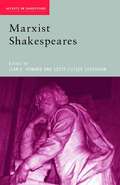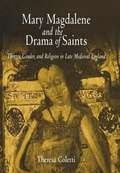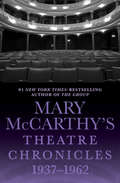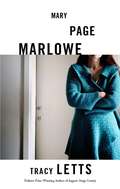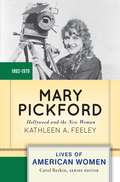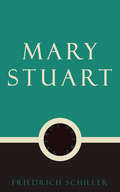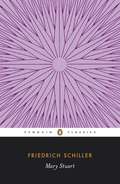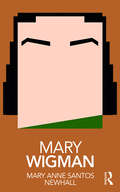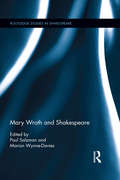- Table View
- List View
Marlowe and Shakespeare
by Robert SawyerInstead of asserting any alleged rivalry between Marlowe and Shakespeare, Sawyer examines the literary reception of the two when the writers are placed in tandem during critical discourse or artistic production. Focusing on specific examples from the last 400 years, the study begins with Robert Greene's comments in 1592 and ends with the post-9/11 and 7/7 era. The study not only looks at literary critics and their assessments, but also at playwrights such as Aphra Behn, novelists such as Anthony Burgess, and late twentieth-century movie and theatre directors. The work concludes by showing how the most recent outbreak of Marlowe as Shakespeare's ghostwriter accelerates due to a climate of conspiracy, including "belief echoes," which presently permeate our cultural and critical discourse.
Marlowe's Ovid: The Elegies in the Marlowe Canon
by M. L. StapletonThe first book of its kind, Marlowe's Ovid explores and analyzes in depth the relationship between the Elegies-Marlowe's translation of Ovid's Amores-and Marlowe's own dramatic and poetic works. Stapleton carefully considers Marlowe's Elegies in the context of his seven known dramatic works and his epyllion, Hero and Leander, and offers a different way to read Marlowe. Stapleton employs Marlowe's rendition of the Amores as a way to read his seven dramatic productions and his narrative poetry while engaging with previous scholarship devoted to the accuracy of the translation and to bibliographical issues. The author focuses on four main principles: the intertextual relationship of the Elegies to the rest of the author's canon; its reflection of the influence of Erasmian humanist pedagogy, imitatio and aemulatio; its status as the standard English Amores until the Glorious Revolution, part of the larger phenomenon of pan-European Renaissance Ovidianism; its participation in the genre of the sonnet sequence. He explores how translating the Amores into the Elegies profited Marlowe as a writer, a kind of literary archaeology that explains why he may have commenced such an undertaking. Marlowe's Ovid adds to the body of scholarly work in a number of subfields, including classical influences in English literature, translation, sexuality in literature, early modern poetry and drama, and Marlowe and his milieu.
Marlowe: Complete Plays
by Christopher MarloweTheir texts fully restored by recent scholarship, Marlowe's astonishing works can now be appreciated as originally written. For the first time, this edition boasts the complete plays - including two versions of Doctor Faustus.Blasphemy, perversion, defiance and transgression ... in a series of compelling tragedies, Marlowe challenged every authority of heaven and earth. From the proud wrath of Tamburlaine, the tyrant of Asia, to the racked anguish of Edward II, himself in thrall to unspeakable desires; from God's own Machiavel, the Duke of Guise, to Barabas, the Jew of Malta, curse of Christianity: all are taboo-breakers, to be broken in their turn. And in the tragedy of Doctor Faustus we perhaps read Marlowe's own: a tale of brilliance and audacity - and of terrible, inexorable punishment.Their texts fully restored by recent scholarship, Marlowe's astonishing works can now be appreciated as originally written. For the first time, this edition boasts the complete plays - including two versions of Doctor Faustus.
Marlowe: The Plays
by Stevie SimkinChristopher Marlowe was the most successful dramatist of his time, his untimely death cutting short a career that may well have rivalled Shakespeare's. His four major works (Doctor Faustus, Edward II, The Jew of Malta and Tamburlaine) are remarkable pieces of theatre, daring explorations of themes such as the nature of kingship, salvation and damnation, sexuality and ethnic prejudice. This book looks in depth at extracts from each of the plays, exploring them in parallel to uncover key concerns, including heroes and anti-heroes, gender and power and politics. As well as guiding readers in an understanding of the place of these issues in their Elizabethan context, and inviting them to consider their resonance today, the book looks in depth at Marlowe's style: his use of rhythm, the complexities and richness of his poetry, and his evolving development of 'character'. Particular attention is given throughout to the plays in performance.
Marmalade Gumdrops
by Carol LauckFantasy / 3m, 4f / Interior / Explores the imaginative world of 10 year old Walter K. Hampton. The play is simply set with actors as furniture in Wally's bedroom, yet moves swiftly through delightful experiences with wind up dolls, and old fashioned melodrama, a circus, story telling, and even a time machine. Led through fun filled antics by Governor Winthrop, his gumdrop popping desk, Libby Bibliophile, his instructive bookcase, Clair Beam, his not too bright lamp, Bedelia Cotter, his yawning bed, and Windsor, his stuffy chair, Wally concludes that, "Imagination is like a marmalade gumdrop; once you've tasted it, you'll never settle for just plain."
Marriage Is Murder
by Nick HallComedy / 1m, 1f / Interior / Ex-spouses Paul and Polly Butler write murder mysteries together. They act out the crimes in Paul's apartment: poisoned chocolates and lethal martinis, alibis and fingerprints, bodies in a trunk and bodies all tied up, daggers, guns and even an axe all contribute to the hilarity. Nobody gets hurt, but their egos take some hits as they find that their marriage was mixed up with their work. There are many fast paced comic twists as they attempt to outdo and surprise each other and they learn that marriage, like murder, is in the details. The final witty complication is a real murder which they and the audience should have seen coming. This murderously funny two character comedy is by the author of Accommodations.
Marriage Proposal (Clark)
by Anton ChekhovShort plays, farce / 2m, 1 f / Interior / Mod. or Russian cost. This little farce is very popular and one of the funniest ever written. The story tells of the efforts of a nervous and excitable man who starts to propose to an attractive young woman, but who gets into a tremendous quarrel over a boundary line.
Marriage and Late-Victorian Dramatists (Bernard Shaw and His Contemporaries)
by Mary ChristianThis book examines plays produced in England in the 1890s and early 1900s and the ways in which these plays responded to changing perceptions of marriage. Bernard Shaw, Oscar Wilde, and other late-Victorian dramatists challenged romanticized ideals of love and domesticity, and, in the process, these authors appropriated and rewrote the genre conventions that had dominated English drama for much of the nineteenth century. In their plays, theater became a forum for debating the problems of traditional marriage and envisioning alternative forms of partnership. This book is written for scholars specializing in the areas of Victorian studies, dramatic literature, theater history, performance studies, and gender studies.
Marriage: A Demolition in Two Acts
by Rick ChafePut away the knives because tensions are rising in this kitchen renovation. What could help patch up a marriage better than a home renovation? Wayne thinks he’s doing his wife Julie a favour by hiring a young couple to help redo the kitchen (at a fraction of the cost she’d hoped for). But Julie has higher standards in mind. John and Maggie think they’ve found a way to make some quick money to pay off the land John bought. John just proposed, but Maggie hasn’t given her answer yet. With both couples on edge amongst themselves and with each other, everything from kitchen cabinets and coffee makers to generational differences and life choices are cause for ridicule, making a play that’s hilarious and relatable.
Marsha Norman: A Casebook (Casebooks on Modern Dramatists #Vol. 19)
by Linda Ginter BrownFirst Published in 1996. Routledge is an imprint of Taylor & Francis, an informa company.
Martha Graham: A special issue of the journal Choreography and Dance (Choreography And Dance Studies Ser.)
by Alice HelpernFirst Published in 1999. Routledge is an imprint of Taylor & Francis, an informa company.
Martin Crimp’s Power Plays: Intertextuality, Sexuality, Desire (Routledge Advances in Theatre & Performance Studies)
by Vicky AngelakiThis book covers playwright Martin Crimp’s recent work showing how it captures the nuances in our interpersonal contemporary experience. Examining the bold and exciting body of writing by Crimp, the book delves into his depiction of intersections between narratives, as well as between private and public, through an honest look at power structures and shifts, marriages and relationships, sexuality, and desire. This book will be of great interest to students and scholars in Drama, Theatre and Performance, English Literature, and Opera Studies.
Martin McDonagh (Routledge Modern and Contemporary Dramatists)
by Catherine ReesThis comprehensive, accessible introduction to one of Britain’s leading contemporary playwrights and filmmakers outlines Martin McDonagh’s body of work, the key critical contexts for understanding and exploring his career, analysis of productions, and includes an exclusive interview with the director of his most recent stage work. Analysis of McDonagh’s writing is broken down into three periods – his early Irish plays, his screenplays, and his later plays that move away from and outside of Ireland. Works are discussed thematically, giving a dynamic reading of the scripts and the ideas around which they circle. The book’s final section then delves in more detail into selected seminal productions of McDonagh’s writing, outlining key phases and transitions in his career.Part of the Routledge Modern and Contemporary Dramatists series, Martin McDonagh is an essential guide for scholars and students who are setting out to understand the life and work of one of the most popular and acclaimed British dramatists and filmmakers of the twenty-first century.
Martin McDonagh: A Casebook (Casebooks on Modern Dramatists)
by Richard Rankin RussellThis book represents the first collection of original critical material on Martin McDonagh, one of the most celebrated young playwrights of the last decade. Credited with reinvigorating contemporary Irish drama, his dark, despairing comedies have been performed extensively both on Broadway and in the West End, culminating in an Olivier Award for the The Pillowman and an Academy Award for his short film Six Shooter. In Martin McDonagh, Richard Rankin Russell brings together a variety of theoretical perspectives – from globalization to the gothic – to survey McDonagh’s plays in unprecedented critical depth. Specially commissioned essays cover topics such as identity politics, the shadow of violence and the role of Catholicism in the work of this most precocious of contemporary dramatists. Contributors: Marion Castleberry, Brian Cliff, Joan Fitzpatrick Dean, Maria Doyle, Laura Eldred, José Lanters, Patrick Lonergan, Stephanie Pocock, Richard Rankin Russell, Karen Vandevelde
Marty McGuire (Marty Mcguire Ser. #1)
by Brian Floca Kate MessnerIn this fun & accessible chapter book, an irrepressible, third-grade tomboy is cast in the class play and brings her own chaotic spin to the show.Marty McGuire would rather spend recess catching frogs in the pond than playing dress-up with the other girls in third grade. So when her teacher casts Marty as the princess in the class play, Marty’s absolutely, positively sure that there’s been a huge mistake. But after a special lesson in the art of improvisation, Marty comes up with her OWN plan to IMPROVE the play: Why use stuffed-animal frog onstage when a live one would be so much better? In the end, Marty’s one-of-a-kind performance makes for an unforgettable show. Maybe Marty CAN live happily ever after, after all!
Martyrs and Players in Early Modern England: Tragedy, Religion and Violence on Stage (Studies in Performance and Early Modern Drama)
by David K. AndersonFocusing on Christopher Marlowe, William Shakespeare, John Webster and John Milton, Martyrs and Players in Early Modern England argues that the English tragedians reflected an unease within the culture to acts of religious violence. David Anderson explores a link between the unstable emotional response of society to religious executions in the Tudor-Stuart period, and the revival of tragic drama as a major cultural form for the first time since classical antiquity. Placing John Foxe at the center of his historical argument, Anderson argues that Foxe’s Book of Martyrs exerted a profound effect on the social conscience of English Protestantism in his own time and for the next century. While scholars have in recent years discussed the impact of Foxe and the martyrs on the period’s literature, this book is the first to examine how these most vivid symbols of Reformation-era violence influenced the makers of tragedy. As the persecuting and the persecuted churches collided over the martyr’s body, Anderson posits, stress fractures ran through the culture and into the playhouse; in their depictions of violence, the early modern tragedians focused on the ethical confrontation between collective power and the individual sufferer. Martyrs and Players in Early Modern England sheds new light on the particular emotional energy of Tudor-Stuart tragedy, and helps explain why the genre reemerged at this time.
Marxist Shakespeares (Accents on Shakespeare)
by Jean E. HowardMarxist Shakespeares uses the rich analytic resources of the Marxist tradition to look at Shakespeare's plays afresh. The book offers new insights into the historical conditions within which Shakespeare's representations of class and gender emerged, and into Shakespeare's role in the global culture industry stretching from Hollywood to the Globe Theatre. A vital resource for students of Shakespeare which includes Marx's own readings of Shakespeare, Derrida on Marx, and also Bourdieu, Bataillle, Negri and Alice Clark.
Mary Magdalene and the Drama of Saints
by Theresa ColettiA sinner-saint who embraced then renounced sexual and worldly pleasures; a woman who, through her attachment to Jesus, embodied both erotic and sacred power; a symbol of penance and an exemplar of contemplative and passionate devotion: perhaps no figure stood closer to the center of late medieval debates about the sources of spiritual authority and women's contribution to salvation history than did Mary Magdalene, and perhaps nowhere in later medieval England was cultural preoccupation with the Magdalene stronger than in fifteenth-century East Anglia.Looking to East Anglian texts including the N-Town Plays, The Book of Margery Kempe, The Revelations of Julian of Norwich, and Bokenham's Legend of Holy Women, Theresa Coletti explores how the gendered symbol of Mary Magdalene mediates tensions between masculine and feminine spiritual power, institutional and individual modes of religious expression, and authorized and unauthorized forms of revelation and sacred speech. Using the Digby play Mary Magdalene as her touchstone, Coletti engages a wide variety of textual and visual resources to make evident the discursive and material ties of East Anglian dramatic texts and feminine religion to broader traditions of cultural commentary and representation.In bringing the disciplinary perspectives of literary history and criticism, gender studies, and social and religious history to bear on specific local instances of dramatic practice, Mary Magdalene and the Drama of Saints highlights the relevance of Middle English dramatic discourse to the dynamic religious climate of late medieval England. In doing so, the book decisively challenges the marginalization of drama within medieval English studies, elucidates vernacular theater's kinship with influential late medieval religious texts and institutions, and articulates the changing possibilities for sacred representation in the decades before the Reformation.
Mary McCarthy's Theatre Chronicles, 1937–1962: Mary Mccarthy's Theatre Chronicles, 1937-1962 And On The Contrary
by Mary McCarthyThe American theatre comes alive in Mary McCarthy&’s provocative anthology of essaysHer literary writings and dramatic criticism have appeared in the New Yorker and the New York Review of Books. Mary McCarthy&’s Theatre Chronicles gathers together a wide-ranging collection featuring a cast of playwrights, actors, and directors that reads like a &“who&’s who&” of American theatre. With chapters ranging from &“The Unimportance of Being Oscar&” to &“Odets Deplored,&” this lively and witty volume opens a revealing window onto every aspect of theatre. McCarthy brings singular productions of the world&’s most famous plays to vivid dramatic life while dissecting literary giants like Tennessee Williams and Arthur Miller. She offers her controversial opinion on everything from the American school of realism as epitomized by Brando to what creates a great actress to how a badly written play can still make for good theatre.With passages on theatre figures from Shakespeare to Shaw to Ibsen and O&’Neill, this is a must-have for theatre lovers and armchair critics everywhere.This ebook features an illustrated biography of Mary McCarthy including rare images from the author&’s estate.
Mary Page Marlowe (TCG Edition)
by Tracy LettsBest known for his portrayals of large-scale family drama, Tracy Letts’ new play narrows in focus, zooming in on the life of just one woman, though her story is no less complex. This intimate snapshot of a simple life provides an enlightening examination of a complicated human mind.
Mary Pickford: Hollywood And The New Woman
by Kathleen A. FeeleyOn screen and off, movie star Mary Pickford personified the "New Woman" of the early 1900s--a moniker given to women who began to demand more autonomy inside and outside the home. Well educated and career-minded, these women also embraced the new mass culture in which consumption and leisure were seen to play a pivotal role in securing happiness. Mary Pickford: Hollywood and the New Woman examines Pickford's role in the rise of industrial capitalism and consumer culture, and uses her life and unprecedented career as a wildly popular actress and savvy film mogul to illustrate the opportunities and obstacles faced by American women during this time. Following Pickford's life from her childhood on stage to her rise as a powerful studio executive, this book gives an overview of her enduring contribution to American film and mass culture. It also explores her struggles to surpass her confining public film persona as "America's Sweetheart" with her creative and business achievements--mirroring how women, both then and today, must reconcile domestic life with professional aspirations and work. About the Lives of American Women series: Selected and edited by renowned women's historian Carol Berkin, these brief biographies are designed for use in undergraduate courses. Rather than a comprehensive approach, each biography focuses instead on a particular aspect of a women's life that is emblematic of her time, or which made her a pivotal figure in the era. The emphasis is on a "good read," featuring accessible writing and compelling narratives, without sacrificing sound scholarship and academic integrity. Primary sources at the end of each biography reveal the subject's perspective in her own words. Study questions and an annotated bibliography support the student reader.
Mary Stuart
by Friedrich Schiller“Mary Stuart” is a play that gives us a fictional account of the last days of Mary Queen of Scots. In it we are treated to an entirely made up scene in which Queen Mary and Queen Elizabeth I meet face to face. And it is the stuff of great drama!
Mary Stuart
by Friedrich SchillerThis dramatic story recounts Mary, Queen of Scots's remaining days held captive in Fotheringay Castle. In scenes alternating between Mary's prison and Elizabeth's court at Westminster, Schiller's play gradually builds a compelling picture of a tragic heroine rising above her suffering to gain in insight and spiritual depth. In contrast Elizabeth, in turmoil over the correct course of action for her country and trapped by the cruel demands of Realpolitik, can achieve worldly victory only at a terrible moral cost. Culminating in a fictitious meeting of the two women, Mary Stuart is a dramatic meditation on the nature of political power, but also a deeply moving human tragedy that captures the emotional essence of complex events.
Mary Wigman: Modernity And Mary Wigman, 1886--1973 (Routledge Performance Practitioners)
by Mary Anne Santos NewhallThis book considers dancer, teacher, and choreographer Mary Wigman, a leading innovator in Expressionist dance whose radical explorations of movement and dance theory are credited with expanding the scope of dance as a theatrical art. Now reissued, this book combines: a full account of Wigman’s life and work an analysis of her key ideas detailed discussion of her aesthetic theories, including the use of space as an "invisible partner" and the transcendent nature of performance a commentary on her key works, including Hexentanz and The Seven Dances of Life an extensive collection of practical exercises designed to provide an understanding of Wigman’s choreographic principles and her uniquely immersive approach to dance. As a first step towards critical understanding, and as an initial exploration before going on to further, primary research, Routledge Performance Practitioners are unbeatable value for today’s student.
Mary Wroth and Shakespeare (Routledge Studies in Shakespeare)
by Paul Salzman Marion Wynne-DaviesOver the last twenty five years, scholarship on Early Modern women writers has produced editions and criticisms, both on various groups and individual authors. The work on Mary Wroth has been particularly impressive at integrating her poetry, prose and drama into the canon. This in turn has led to comparative studies that link Wroth to a number of male and female writers, including of course, William Shakespeare. At the same time no single volume has attempted a comprehensive comparative analysis. This book sets out to explore the ways in which Wroth negotiated the discourses that are embedded in the Shakespearean canon in order to develop an understanding of her oeuvre based, not on influence and imitation, but on difference, originality and innovation.
